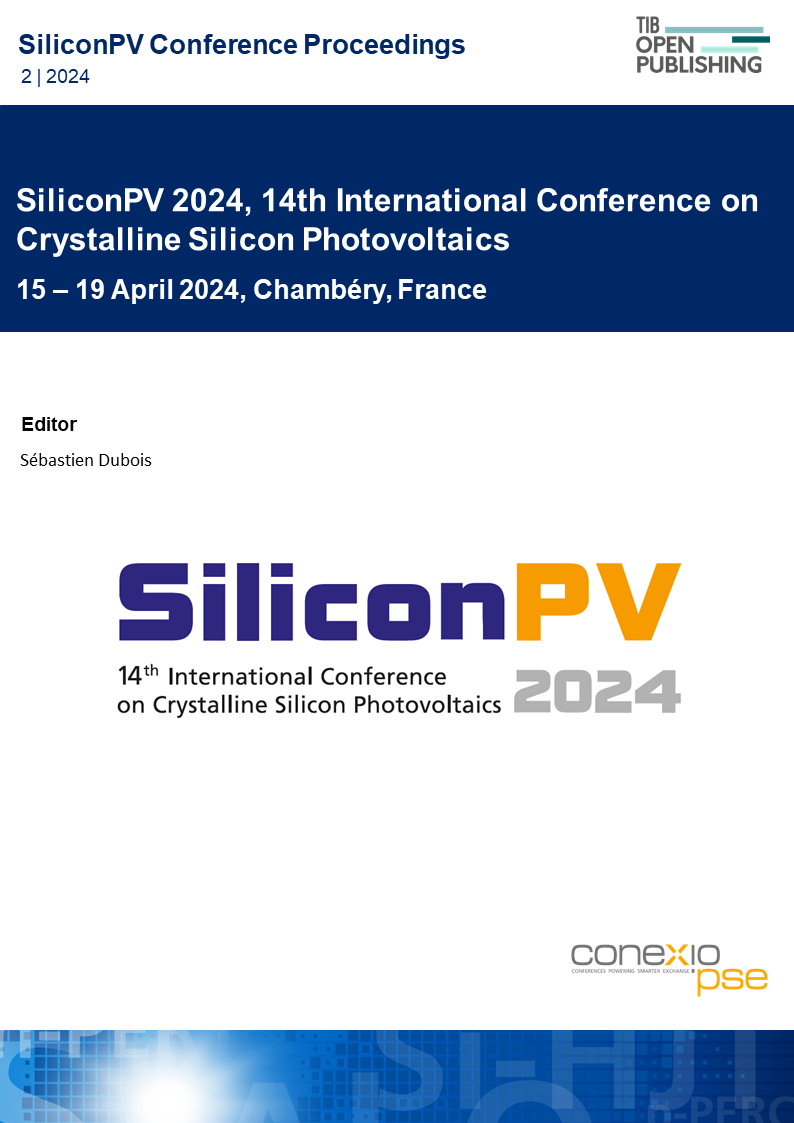Accuracy of PVSyst Simulations in the Reproduction of the Yield Performance of Multicrystalline, Monocrsytalline and Monocasting Modules in Outdoor Conditions
DOI:
https://doi.org/10.52825/siliconpv.v2i.1299Keywords:
Silicon, Cast-mono, Multicrystalline, Monocrystalline, Outdoor Performance, SimulationAbstract
In this study we performed field tests on three small installations consisting of 12 modules each and next to each other, all of them using exactly the same manufacturing technology for cells and modules and employing the same manufacturing equipment and raw materials. The only difference between the systems was the wafer technology used. Two of them were manufactured through the same casting technology (Direct solidification system-DSS) and the same equipment: in one of them we grew mc-Si and in the other one CM-Si (mono casting). In the third system we used traditional Czochralski monocrystalline wafers as technology. Two of the facilities (the DSS based ones) have been closely monitored for three years, and the traditional monocrystalline one for 17 months. For the three installations the performance data is shared and compared with PVsyst simulations and correlated well to each other.
Downloads
References
[1] M. Kivambe, B. Aissa and N. Tabet, "Emerging Technologies in Crystal Growth of Photovoltaic Silicon: Progress and Challenges", SNEC 11th International Photovoltaic Power Generation Conference & Exhibition. SNEC 2017 Scientific Conference, 17-20 April 2017, Shanghai, China.
[2] C.W. Lan “Twenty years crystal growth of solar silicon: My serendipity journey” Journal of Crystal Growth, 626 (2024), 127480. DOI: https://doi.org/10.1016/j.jcrysgro.2023.127480
[3] N. Stoddard, B. Wu, I. Witting, M. C. Wagener, Y. Park, G. A. Rozgonyi, R. Clark, Casting Single Crystal Silicon: Novel Defect Profiles from BP Solar's Mono2TM Wafers, Solid State Phenomena, 2007, 131–133 : 1–8, https://doi.org/10.4028/www.scientific.net/ssp.131-133.1. DOI: https://doi.org/10.4028/www.scientific.net/SSP.131-133.1
[4] J.L. de Souza Silva, T. Silva Costa, K. Barbosa de Melo, E. Yoiti Sako, H. Soeiro Moreira and M. Gradella Villalba, “A comparative Performance of PV Power Simulation Software with an installed PV Plant”, 2020 IEEE International Conference on Industrial Technology (ICIT), 26-28 February 2020, Buenos Aires, Argentina. DOI: https://doi.org/10.1109/ICIT45562.2020.9067138
[5] J. Freeman; J. Whitmore; N. Blair; A. P. Dobos, “Validation of multiple tools for flat plate photovoltaic modeling against measured data”, 2014 IEEE 40th Photovoltaic Specialist Conference (PVSC), 08-13 June 2014, Denver, USA DOI: https://doi.org/10.1109/PVSC.2014.6925304
[6] D.D. Milosavljević, T.S. Kevkić and S.J. Jovanović, “Review and validation of photovoltaic solar simulation tools/software based on case study”, https://doi.org/10.1515/phys-2022-0042, Gruyter Open Access May 27, 2022, Open Physics, Volume 20, issue 1 DOI: https://doi.org/10.1515/phys-2022-0042
Downloads
Published
How to Cite
Conference Proceedings Volume
Section
License
Copyright (c) 2024 Ismael Guerrero, Carlos del Cañizo, Yuanjie Yu

This work is licensed under a Creative Commons Attribution 4.0 International License.
Accepted 2024-09-22
Published 2025-02-03
Funding data
-
Ministerio de Ciencia e Innovación
Grant numbers PID2020-113533RB-C31
